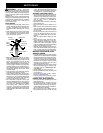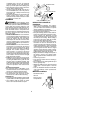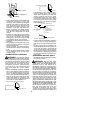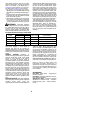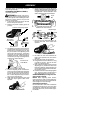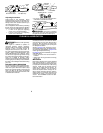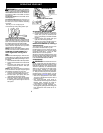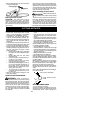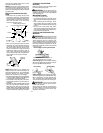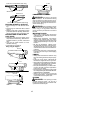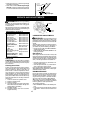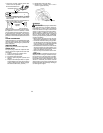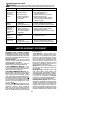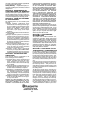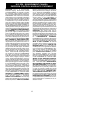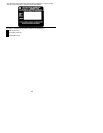
11
made on the opposite side of tree, the tree
will tend to fall into the notch.
NOTE:
If the tree has large buttress roots,
removethem beforemaking thenotch. If u s-
ing saw to remove buttress roots, keep saw
chain fromcontactinggroundtopreventdull-
ing o f the chain.
NOTCH CUT AND FELLING THE
TREE
S Make notch cut by cutting the top of the
notch first. Cut through
1/3
of the diameter
ofthetree.Nextcomplete thenotchbycut-
ting the bottom of the notch. See illustra-
tion. Once the notch i s cut remove the
notch of wood from the tree.
Notch
First cut
Second cut
Final (felling) cut here.
2! (5 cm) above center of notch.
5cm
5cm
Hinge
S After removing the cutout of wood, make
the felling cut on the opposite side of the
notch. This is done by making a cut about
two inches hi gher than the center of the
notch. This will leave enoughuncut wood
between the felling cut and the notch to
form a hinge. This hinge will help prevent
the tree from falling in thewrongdirection.
Opening
of felling
cut
Closing
of
notch
Hinge holds tree on stump and helps
control fall
NOTE
: Before felling cut is complete, use
wedges to open the cut when necessary to
controlthedirectionoffall. To avoidkickback
and chain damage, use wood or pl astic
wedges, but never steel or iron wedges.
S Be a lert to signs that the t ree is ready to fall:
cracking sou nds, widening of t he fe lling cu t,
or movement in the up per branches.
S A s tree star ts to fall, stop saw, put it down,
and get away quickly on your planned re-
treat path.
S DO N O Tcut dow na par tially fallen t r eewith
your saw . Be extremely cautious with par-
tially fallen trees that may be p oorly sup-
ported. When a tree doesn’t fall completely ,
set the saw aside and pull down thetree with
a cable winch, block andtackle, ortractor.
CUTTING A FALLEN TREE
(BUCKING)
Bucking is the term used for cutting a fallen
tree to the desired log l ength.
WARNING:
Do not stand on the log
being cut. Any portion can roll causing loss
of footing and control. Do not stand downhill
of the log being cut.
IMPORTANT POINTS
S Cut only one log at a time.
S Cut shattered wood very carefully; sharp
pieces ofwoodcouldbeflung towardoper-
ator.
S Use a sawhorse to cut s mall logs. Never
allow another person t o hold the log while
cuttingand neverholdthe logwith your leg
or foot.
S Do not cut in an area where logs, limbs,
and roots are tangled.Drag thelogs into a
clear area beforecutting by pulling outex-
posed and cleared logs first.
TYPES OF CUTTING USED FOR
BUCKING
WARNING:
Ifsaw becomespinched
or hung in a log, don’t try to force it out. You
can lose control of thesaw resulting in injury
and/or damage to the saw. Stop the saw,
drive a wedge of plastic or wood into the cut
until thesaw canberemovedeasily. Restart
thesaw andcarefully reenterthe cut. Do not
attempttorestartyoursaw whenit is pinched
or hung in a log.
Turn saw
OFF
and use a plastic or
wooden wedge to force cut open.
Use a wedge to remove pinchedsaw
Overcuttingbeginson thetopside ofthelog
with t hesaw against the log. When overcut-
ting use light downward pressure.
Overcutting Undercutting
Undercuttinginvolves cuttingon theunder-
side ofthelog with topof sawagainst thelog.
When undercutting use light upward pres-
sure. Hold saw firmly and maintain control.
The saw will tend to push back toward you.
WARNING:
Never turn saw upside
down to undercut. The saw cannot be con-
trolled in t his position.
Always make your fi rst cut on the compres-
sion side ofthelog. Thecompression sideof
the log is where the pressure of the log’s
weight is concentrated.



